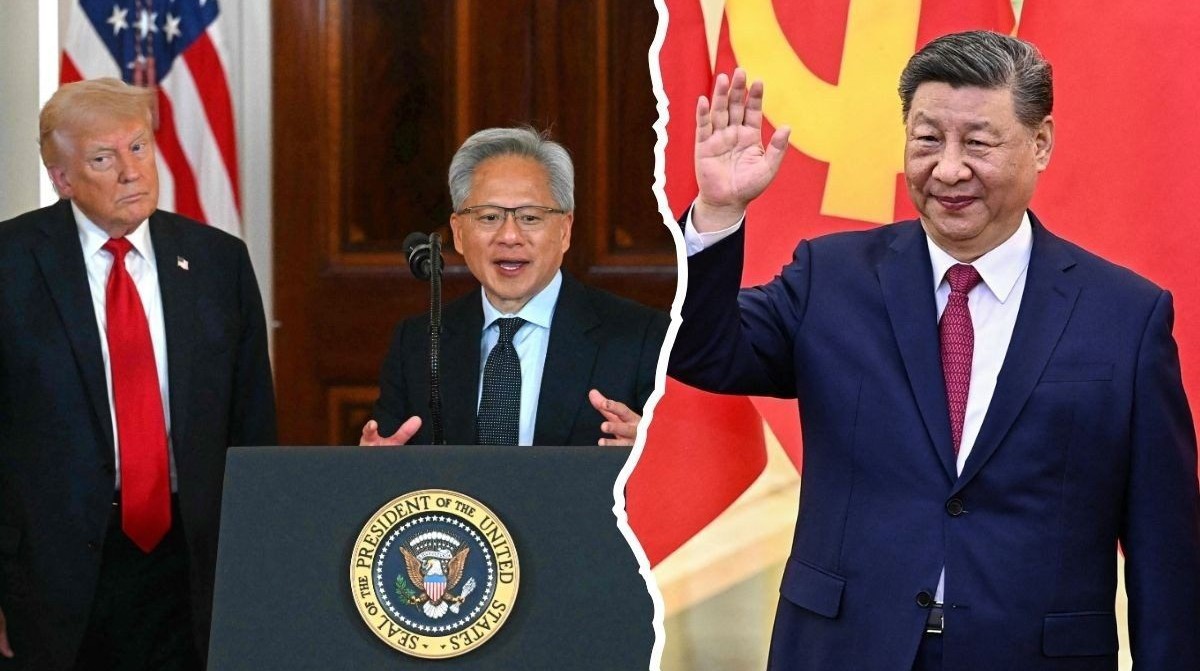In 2022, NVIDIA was locked out of China’s booming AI chip market. By April 2025, U.S. restrictions went further — an outright ban on selling advanced AI processors to China. Overnight, both NVIDIA and AMD lost access to their most lucrative international customer base.
Then came an unprecedented reversal.
In June, NVIDIA CEO Jensen Huang met privately with President Donald Trump. It wasn’t a public summit, nor a carefully lawyered negotiation. No lobbyists. No legal teams. Just two men deciding the fate of a $23 billion market over the course of a private meeting.
The deal they struck has no precedent in U.S. economic policy: a revenue-sharing agreement.
The Unthinkable Becomes Reality
Trump’s opening demand was bold: 20% of every dollar NVIDIA and AMD make selling AI chips to China would go directly to the U.S. government. Huang pushed back — and settled at 15%. In return, the administration would grant export licenses for AI chips once again.
This wasn’t a tariff (which would require Congressional approval), nor a fine (which would imply wrongdoing). It’s being called a “voluntary revenue share” — though in practice, the companies had little choice.
Why would they accept?
Because China’s AI industry is desperate for NVIDIA’s H20 and AMD’s MI308 chips — specialized processors powering the machine learning backbone of Chinese data centers. Even though these chips are deliberately underpowered to meet export compliance rules, they’re still far ahead of anything China can manufacture domestically. Without them, Beijing’s AI ambitions would grind to a halt.
The Leverage Game
The April ban gave Trump unprecedented leverage:
“Want access to China? Pay us.”
China accounts for 13% of NVIDIA’s total revenue (about $17 billion) and 24% for AMD (about $6.2 billion). A 15% skim from the top means the U.S. government will collect billions annually — effectively taxing one of America’s most profitable tech sectors without passing a single law.
For high-margin AI chips, that 15% slice erases roughly a quarter of actual profits.
And yet, the alternative was worse: zero access to a market that could double in the next decade.
The Market Reacts — and Worries
NVIDIA’s stock surged on the announcement. Investors saw restored China revenue as a win. But beneath the euphoria, a more troubling precedent is taking shape: if Washington can impose a “voluntary” 15% on AI chips, what stops it from demanding 20% on pharmaceuticals? Or 30% on energy infrastructure?
Legal experts are already drafting constitutional challenges, warning that this blurs the line between executive power and corporate property rights. For multinational CEOs, it’s a wake-up call: geopolitical access is now a negotiable asset, not an entitlement.
Why This Matters for Offshore Investors
For offshore investors, the NVIDIA-China deal signals a new era of transactional trade diplomacy — where market access can be bought, sold, or taxed at the negotiating table. It also reinforces the strategic importance of supply chain choke points — in this case, high-end AI processors.
The global AI race won’t slow down, and China’s dependency on U.S. chip technology remains a key bargaining chip for Washington. For investors, this opens two opportunities:
- Long positions in companies holding irreplaceable tech IP.
- Hedging strategies against sudden policy-driven profit cuts.
One thing is clear — sales to major markets are no longer just about price and demand. They’re about political leverage. And those who can navigate that leverage will win.
Invest Offshore continues to monitor how U.S. policy innovations — or overreaches — create ripple effects in global markets. We also have investment opportunities in West Africa seeking investors for the Copperbelt Region.

Leave a Reply